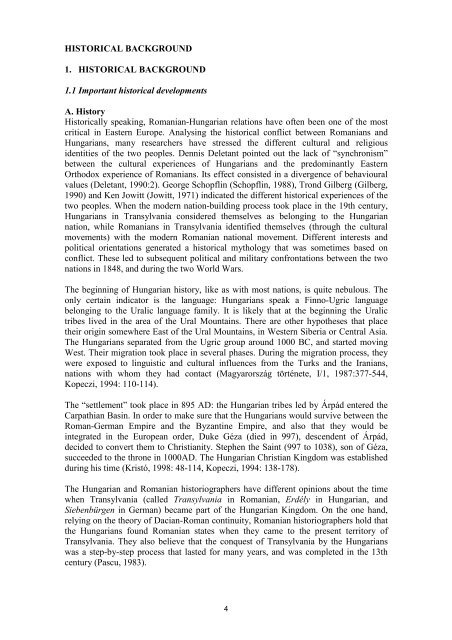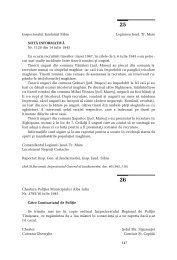Southeast Europe
Southeast Europe
Southeast Europe
You also want an ePaper? Increase the reach of your titles
YUMPU automatically turns print PDFs into web optimized ePapers that Google loves.
HISTORICAL BACKGROUND<br />
1. HISTORICAL BACKGROUND<br />
1.1 Important historical developments<br />
A. History<br />
Historically speaking, Romanian-Hungarian relations have often been one of the most<br />
critical in Eastern <strong>Europe</strong>. Analysing the historical conflict between Romanians and<br />
Hungarians, many researchers have stressed the different cultural and religious<br />
identities of the two peoples. Dennis Deletant pointed out the lack of “synchronism”<br />
between the cultural experiences of Hungarians and the predominantly Eastern<br />
Orthodox experience of Romanians. Its effect consisted in a divergence of behavioural<br />
values (Deletant, 1990:2). George Schopflin (Schopflin, 1988), Trond Gilberg (Gilberg,<br />
1990) and Ken Jowitt (Jowitt, 1971) indicated the different historical experiences of the<br />
two peoples. When the modern nation-building process took place in the 19th century,<br />
Hungarians in Transylvania considered themselves as belonging to the Hungarian<br />
nation, while Romanians in Transylvania identified themselves (through the cultural<br />
movements) with the modern Romanian national movement. Different interests and<br />
political orientations generated a historical mythology that was sometimes based on<br />
conflict. These led to subsequent political and military confrontations between the two<br />
nations in 1848, and during the two World Wars.<br />
The beginning of Hungarian history, like as with most nations, is quite nebulous. The<br />
only certain indicator is the language: Hungarians speak a Finno-Ugric language<br />
belonging to the Uralic language family. It is likely that at the beginning the Uralic<br />
tribes lived in the area of the Ural Mountains. There are other hypotheses that place<br />
their origin somewhere East of the Ural Mountains, in Western Siberia or Central Asia.<br />
The Hungarians separated from the Ugric group around 1000 BC, and started moving<br />
West. Their migration took place in several phases. During the migration process, they<br />
were exposed to linguistic and cultural influences from the Turks and the Iranians,<br />
nations with whom they had contact (Magyarország története, I/1, 1987:377-544,<br />
Kopeczi, 1994: 110-114).<br />
The “settlement” took place in 895 AD: the Hungarian tribes led by Árpád entered the<br />
Carpathian Basin. In order to make sure that the Hungarians would survive between the<br />
Roman-German Empire and the Byzantine Empire, and also that they would be<br />
integrated in the <strong>Europe</strong>an order, Duke Géza (died in 997), descendent of Árpád,<br />
decided to convert them to Christianity. Stephen the Saint (997 to 1038), son of Géza,<br />
succeeded to the throne in 1000AD. The Hungarian Christian Kingdom was established<br />
during his time (Kristó, 1998: 48-114, Kopeczi, 1994: 138-178).<br />
The Hungarian and Romanian historiographers have different opinions about the time<br />
when Transylvania (called Transylvania in Romanian, Erdély in Hungarian, and<br />
Siebenbürgen in German) became part of the Hungarian Kingdom. On the one hand,<br />
relying on the theory of Dacian-Roman continuity, Romanian historiographers hold that<br />
the Hungarians found Romanian states when they came to the present territory of<br />
Transylvania. They also believe that the conquest of Transylvania by the Hungarians<br />
was a step-by-step process that lasted for many years, and was completed in the 13th<br />
century (Pascu, 1983).<br />
4









